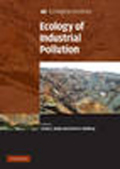
Written for researchers and practitioners in environmental pollution, management and ecology, this interdisciplinary account explores the ecological issuesassociated with industrial pollution to provide a complete picture of this important environmental problem from cause to effect to solution. Bringing together diverse viewpoints from academia and environmental agencies and regulators, the contributors cover such topics as biological resources of mining areas, biomonitoring of freshwater and marine ecosystems and risk assessment of contaminated land in order to explore important questions such as: What are the effects of pollutants on functional ecology and ecosystems? Do current monitoringtechniques accurately signal the extent of industrial pollution? Does existing policy provide a coherent and practicable approach? Case studies from throughout the world illustrate major themes and provide valuable insights into the positive and negative effects of industrial pollution, the provision of appropriate monitoring schemes and the design of remediation and restoration strategies. INDICE: List of contributors; Preface; 1. Consequences of living in an industrial world Lesley C. Batty and Kevin B. Hallberg; 2. Metallophytes: the unique biological resource, its ecology and conservational status in Europe, central Africa and Latin America Alan J. M. Baker, Wilfred H. O. Ernst, Antony vander Ent, F. Malaisse and Rosanna Ginocchio; 3. Lichens and industrial pollution William Purvis; 4. The impacts of metalliferous drainage on aquatic communities in rivers and streams Lesley C. Batty, Montserrat Auladell and Jon Sadler; 5. Impacts of emerging contaminants on the environment Alistair Boxall; 6. Ecological monitoring and assessment of pollution in rivers J. Iwan Jones, JohnDavy-Bowker, John F. Murphy and James L. Pretty; 7. Detecting ecological effects of pollutants in the aquatic environment Alastair Grant; 8. With the benefit of hindsight: the utility of palaeoecology in wetland condition assessment and identification of restoration targets Peter Gell; 9. An ecological risk assessment framework for assessing risks from contaminated land in England and Wales Stephen Roast, Tim Gannicliffe, Danielle K. Ashton, Rachel Benstead, PaulR. Bradford, Paul Whitehouse and Declan Barraclough; 10. Diversity and evolution of microorganisms and pathways for the degradation of environmental contaminants: a case study with the s-triazine herbicides Michael Sadowsky; 11. The microbial ecology of land and water contaminated with radioactive waste: towards the development of bioremediation options for the nuclear industry Andrea Geissler, Sonja Selenska-Pobell, Katherine Morris, Ian T. Burke, Francis R. Livens and Jonathan R. Lloyd; 12. The microbial ecology of remediating industrially-contaminated land: sorting out the bugs in the system Ken Killham; 13. Ecological recovery in a river polluted to its sources: the river Tame in the English Midlands Terry E. Langford, Peter J. Shaw, Shelley R. Howard, Alastair J. D. Ferguson, David Ottewell and Rowland Eley; 14. Manchester ship canal and Salford quays: industrial legacy and ecological restoration Adrian E. Williams, Rachel J. Waterfall, Keith N. White and Keith Hendry; 15. Large-scale mine site restoration of Australian eucalypt forests after bauxite mining: soil management and ecosystem development Mark Tibbett; 16. Sustaining industrial activity and ecological quality: the potential roles of an ecosystem services approach Lorraine Maltby, Achim Paetzold and Philip Warren; Index
- ISBN: 978-0-521-73038-9
- Editorial: Cambridge University Press
- Encuadernacion: Rústica
- Páginas: 350
- Fecha Publicación: 01/03/2010
- Nº Volúmenes: 1
- Idioma: Inglés
